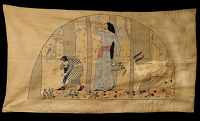
Constance Armfield
Damsels in a Wood, 1916

Constance Armfield (1876 - 1941)
Smedley [married name Armfield], (Annie) Constance, author and founder of the International Lyceum Clubs, was born in Trinity Road, Handsworth, Birmingham, on 20 June 1876, the elder daughter and first among the three children of William Thomas Smedley (1851–1934), a chartered accountant, and his wife, Annie Elizabeth (1851–1923), daughter of William Duckworth, a Birmingham coffee merchant, and his wife, Elizabeth Seaborn (1776–1854).
Smedley began her education at home before attending King Edward VI High School for Girls and Birmingham School of Art. Her severe physical disability, probably caused by childhood polio—which confined her to crutches, and, from her mid-thirties, to a wheelchair—rarely prevented her from pursuing her ambitions, or attracting admiring attention. She excelled at art school, publishing her first illustration, in Pall Mall Magazine, at sixteen, yet her interests shifted toward writing for the theatre. Through a combination of personal acquaintance and initiative, she attracted the attention of eminent theatrical figures, notably Sir Charles Wyndham, Mary Moore, and Mrs Patrick Campbell. While she was in her early twenties several of her plays were staged, including Mrs Jordan, with Campbell in the title role. Her family moved to London, where she mixed in artistic circles, associating with, among others, Richard Le Gallienne, Alice Meynell, and Gertrude Hudson. Her 'Princess' series in the St James's Gazette, dramatizing the dilemmas of modern womanhood, appeared as The Boudoir Critic in 1903, the same year as her first novel, An April Princess, about a young woman's rebellion against her philistine Victorian family. The works were, to an extent, self-referential. Smedley had two nicknames among her intimate circle: the Princess, a tribute to her benevolence and fantastical imagination; and Peter (the fairy-tale miller's third son), recognizing her longing for masculine freedom and adventure.
The books, the first of over forty, coincided with the beginning of Smedley's career as founder and honorary secretary of the International Lyceum Clubs for Women Artists and Writers, established to provide professional women with institutional support. In her vision the clubs were pioneering. She aspired, not only to enable women to compete equally with men, but to create a democratic, non-hierarchical, centre for worldwide cultural exchange, and travelled across Europe, helping women in Amsterdam (1904), Berlin (1905), Paris (1906), and Florence (1908) to open clubhouses.
Despite ambassadorial and administrative commitments Smedley continued to write for adults and children. Works published during her Lyceum years include Conflict (1907), a novel about the unsheltered lives of working women, and Women: a Few Shrieks (1907), a feminist polemic. Her encounters in the art world, through the Lyceum, eventually led her away from the institution. Meetings in Germany with Count Harry Kessler and Ruth St Denis were particularly important for the development of her beliefs and theatre practice. Kessler, the art patron who promoted Gordon Craig, encouraged her dedication to international peace and synthetic theatre. St Denis, the modernist dancer, identified rhythm as the basis of all art, and introduced Smedley to the Christian Science church, of which she became a lifelong member.
On 20 January 1909 Smedley married Maxwell Ashby Armfield (1881–1972), painter, illustrator, and writer. They had an unconventional partnership: her handicap, and his sexual preference for men, precluded full marital relations, and thus children. Yet their intense working relationship, and romantic friendship, led to fertile collaboration in literature and theatre. Upon their marriage Smedley resigned from the Lyceum, and they set up house at The Uplands, Minchinhampton (and from 1912 at Rodborough Common) in the Cotswolds, writing and illustrating books together. They founded the Cotswold Players, for which they both wrote plays, developing symbolist performance techniques, and a philosophy of communal, democratic art.
At the outbreak of the First World War the Armfields moved to Glebe Place, Chelsea, en route for America, where they hoped to participate in the 'little theatre' scene. They established a new drama company, the Greenleaf Theatre, promulgating their radical methods, and played a prominent part in an avant-garde, anti-war community centred on Margaret Morris's theatre on the King's Road, which included Morris herself, Hilda Spencer Watson, Geoffrey Whitworth, Vernon Lee, Haddon Squire, Henrietta Leslie, and McKnight Kauffer. At the end of 1915 they procured visas for America, where they directed and taught Greenleaf drama for seven years, basing themselves in New York and Berkeley.. Armfield, however, wanted more seclusion, so, to Smedley's regret, they returned to England in 1922, setting up a Greenleaf studio at Mockbeggar Hill, Ibsley, the New Forest, and then at 8a Clareville Grove, South Kensington. Her publications during the 1920s included Tales from Timbuktu (1923, for children), Justice Walk (1924), Greenleaf Rhythmic Plays (1922–5), and Greenleaf Theatre Elements (1924–6, theatre textbooks). Her autobiography, Crusaders (1929), which unabashedly promotes herself and her work, captures her theatrical extravagance and warmth of character.
Deteriorating health and finances blighted Constance Smedley's last decade. The Greenleaf folded, and her publications dwindled. In 1939 she and Armfield moved to the Old Coaching Inn, 15a High Street, West Wycombe, where she died of heart failure on 9 March 1941. Her death may have been avoidable, but her Christian Scientist faith discouraged her from receiving treatment for her final illness, or for the cataracts that afflicted her towards the end of her life. She was buried on 14 March at St Lawrence's Church, West Wycombe. Her final obscurity has clouded her earlier achievements, yet her eloquence, inventiveness, and audacity, conveyed through all her projects, have made a lasting impact. Her writing remains fresh and persuasive, while the Cotswold Players and International Lyceum Clubs continue to thrive.
With thanks to artbiogs.co.uk
 sold
sold  reserved
reserved  private collection
private collection